- The Unseen Guardian: Why Pool pH Matters So Much
- Decoding Your Pool's Chemical Blueprint: Understanding pH Levels
- Your Action Plan: How to Raise Pool pH Effortlessly
- The Go-To Solutions: pH Increaser and Soda Ash Explained
- Your Step-by-Step Guide to pH Adjustment
- Pitfalls to Avoid When Adjusting pH
- Maintaining Your Pool's Perfect Balance
Raise Pool pH: Stunning, Effortless Guide
Raise pool pH and unlock the secret to a sparkling, comfortable swimming experience. Many pool owners focus heavily on chlorine levels, but a balanced pH is arguably the most critical factor for both swimmer comfort and equipment longevity. An imbalanced pH can lead to a host of problems, from stinging eyes to corroded equipment, making your pool less inviting and more costly to maintain. This guide will walk you through everything you need to know about understanding, adjusting, and maintaining your pool’s perfect pH balance with stunning ease.
The Unseen Guardian: Why Pool pH Matters So Much
pH is a measure of how acidic or basic your pool water is, ranging from 0 (highly acidic) to 14 (highly basic), with 7 being neutral. For pool water, the ideal pH range is typically between 7.4 and 7.6, though some experts may suggest up to 7.8. This range closely matches the pH of human tears, ensuring maximum swimmer comfort.
When your pool’s pH falls below 7.4, it becomes too acidic. Acidic water can:
Corrode metal components, including ladders, heaters, and pump parts.
Etch and damage pool surfaces, especially plaster.
Cause red, stinging eyes and dry, itchy skin for swimmers.
Reduce the effectiveness of chlorine, meaning you need more sanitizer to do the same job.
Deplete Total Alkalinity, making pH levels unstable.
Conversely, if your pH is too high (above 7.8), the water becomes too basic or alkaline. High pH can:
Cause cloudy water.
Lead to scale formation on pool surfaces and equipment ( unsightly white crust).
Reduce chlorine’s efficiency even more drastically than low pH.
Cause skin and eye irritation, though generally less severe than low pH.
Maintaining the correct pH isn’t just about comfort; it’s about protecting your investment and ensuring your sanitizer works at peak performance.
Decoding Your Pool’s Chemical Blueprint: Understanding pH Levels
Before you can adjust your pH, you need to accurately test your water. There are several reliable methods for testing pool water:
Test Strips: The most convenient and fastest option. Dip a strip into the water, wait for 15-30 seconds, and compare the color changes to the chart on the bottle.
Liquid Test Kits: Often provide more accurate results than strips, especially for pH and chlorine. They involve adding drops of reagents to water samples and comparing colors.
Digital Testers: The most precise but also the most expensive option. These devices give a direct numerical reading of your water’s chemical levels.
Always follow the manufacturer’s instructions for your chosen testing method to ensure accuracy. Take samples from elbow-deep water, away from skimmers or return jets, for a representative reading.
Your Action Plan: How to Raise Pool pH Effortlessly
Once you’ve confirmed your pool’s pH is too low, it’s time to take action. The process of increasing pH is straightforward, primarily involving the addition of specific chemicals designed for this purpose.
The Go-To Solutions: pH Increaser and Soda Ash Explained
The most common and effective chemical used to raise pool pH is pH Increaser. This product is typically granular and contains Soda Ash, which is chemically known as sodium carbonate.
pH Increaser (Sodium Carbonate/Soda Ash): This is your primary weapon against low pH. When added to water, soda ash dissolves and increases the alkalinity, thereby raising the pH. It works relatively quickly and is highly effective. Most pool supply stores stock products labeled “pH Increaser” or “pH Up,” which will contain soda ash as the main active ingredient.
While sodium bicarbonate (baking soda) can also raise pH, its primary role is to increase Total Alkalinity (TA). While a higher TA will buffer the pH and make it more stable, sodium bicarbonate has less of an immediate impact on pH compared to soda ash, especially when a significant increase is needed. For directly raising pH, Soda Ash is the preferred choice.
Your Step-by-Step Guide to pH Adjustment
Here’s an effortless method to raise your pool’s pH to the ideal range:
1. Re-Test Your Water: Even if you tested recently, always re-test just before adding chemicals to confirm the current pH level and ensure you’re addressing the right problem.
2. Calculate the Dose: Read the instructions on your pH Increaser (soda ash) product carefully. The amount needed will depend on your pool’s volume and the severity of the pH imbalance. As a general guideline, many products suggest adding around 6-8 ounces (170-227 grams) of soda ash per 10,000 gallons (37,850 liters) of water to raise pH by approximately 0.2. Always start with less than you think you need – you can always add more.
3. Prepare the Solution: Never add powdered chemicals directly into the pool in a concentrated clump. In a clean, dedicated bucket, dissolve the measured amount of pH Increaser in about 2-3 gallons (7.5-11 liters) of pool water. Stir well until it’s mostly dissolved. Always add the chemical to water, not water to the chemical, to prevent splash-back.
4. Disperse Evenly: With your pool pump running, slowly pour the diluted solution around the perimeter of the pool, avoiding skimmer openings, return jets, and areas where swimmers might congregate directly afterward. Spreading it out helps with even distribution and prevents concentration in one area. If you have a significant amount to add, split it into two or three smaller additions separated by 30-60 minutes to allow better mixing.
5. Circulate and Wait: Allow your pool pump to run for at least 4-6 hours, or preferably overnight, to thoroughly circulate the water and distribute the adjuster.
6. Re-Test and Re-Apply (If Needed): After the circulation period, re-test your pool water. If the pH is still below the ideal range, repeat the process. Remember, it’s always better to make gradual adjustments rather than adding too much chemical at once, which could push your pH too high and create a new problem.
Pitfalls to Avoid When Adjusting pH
Overdosing: Adding too much pH Increaser at once can cause a rapid spike in pH, leading to cloudy water and potentially requiring you to lower the pH, creating a frustrating cycle.
Not Dissolving: Pouring undissolved powder directly into the pool can lead to concentrated patches that can damage liners and surfaces, or simply be less effective.
Ignoring Total Alkalinity (TA): While increasing pH, always be mindful of your TA. If TA is very low, it might be contributing to unstable pH. Addressing TA first can help pH stabilize.
Adding While Swimmers Are Present: Never add chemicals while people are in the pool. Wait for them to exit and allow proper circulation and dispersion.
Maintaining Your Pool’s Perfect Balance
Once you’ve successfully adjusted your pool’s pH, the goal shifts to maintaining it. Regular testing is paramount – at least 2-3 times per week, or daily during heavy use or after significant weather events like heavy rain.
Several factors can cause your pH to fluctuate:
Rainfall: Often slightly acidic, rain can lower your pool’s pH.
Swimmer Load: Bathers introduce various substances that can affect water chemistry.
Chemicals: Some sanitizers, particularly liquid chlorine, can slightly lower pH over time.
By regularly monitoring your pH and making small, proactive adjustments as needed with your chosen pH Increaser (soda ash), you can ensure your pool remains a consistently inviting and safe oasis.



